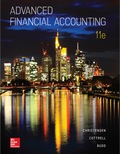
EBK ADVANCED FINANCIAL ACCOUNTING
11th Edition
ISBN: 8220102796096
Author: Christensen
Publisher: YUZU
expand_more
expand_more
format_list_bulleted
Concept explainers
Question
Chapter 3, Problem 3.16Q
To determine
Introduction: The fiscal period of a company is defined asthe accounting period of the company when all the financial reports and the consolidated
To explain:The steps to be done to reconcile the difference in period at the time of consolidation for a parent company and subsidiary company.
Expert Solution & Answer
Want to see the full answer?
Check out a sample textbook solution
Students have asked these similar questions
I am searching for the correct answer to this financial accounting problem with proper accounting rules.
Please solve this General accounting questions step by step
Solve this financial accounting problem
Chapter 3 Solutions
EBK ADVANCED FINANCIAL ACCOUNTING
Ch. 3 - What is the basic idea underlying the preparation...Ch. 3 - How might consolidated statements help an investor...Ch. 3 - Prob. 3.3QCh. 3 - Prob. 3.4QCh. 3 - Prob. 3.5QCh. 3 - Prob. 3.6QCh. 3 - Prob. 3.7QCh. 3 - Prob. 3.8QCh. 3 - Prob. 3.9QCh. 3 - Prob. 3.10Q
Ch. 3 - Prob. 3.11QCh. 3 - Prob. 3.12QCh. 3 - What is meant by indirect control? Give an...Ch. 3 - Prob. 3.14QCh. 3 - Prob. 3.15QCh. 3 - Prob. 3.16QCh. 3 - Prob. 3.17QCh. 3 - Prob. 3.18QCh. 3 - Prob. 3.1CCh. 3 - Prob. 3.2CCh. 3 - Prob. 3.3CCh. 3 - Prob. 3.6CCh. 3 - Prob. 3.7CCh. 3 - Prob. 3.1.1ECh. 3 - Prob. 3.1.2ECh. 3 - Prob. 3.1.3ECh. 3 - Prob. 3.1.4ECh. 3 - Multiple-Choice Question on Variable Interest...Ch. 3 - Multiple-Choice Question on Variable Interest...Ch. 3 - Prob. 3.2.3ECh. 3 - Prob. 3.2.4ECh. 3 - Prob. 3.3.1ECh. 3 - Prob. 3.3.2ECh. 3 - Prob. 3.3.3ECh. 3 - Prob. 3.4.1ECh. 3 - Prob. 3.4.2ECh. 3 - Prob. 3.4.3ECh. 3 - Prob. 3.4.4ECh. 3 - Prob. 3.5ECh. 3 - Prob. 3.6ECh. 3 - Prob. 3.7ECh. 3 - Prob. 3.8ECh. 3 - Prob. 3.9ECh. 3 - Reporting for a Variable Interest Entity Gamble...Ch. 3 - Prob. 3.11ECh. 3 - Prob. 3.12ECh. 3 - Prob. 3.13ECh. 3 - Noncontrolling Interest Sanderson Corporation...Ch. 3 - Prob. 3.15ECh. 3 - Prob. 3.16ECh. 3 - Prob. 3.17ECh. 3 - Prob. 3.18ECh. 3 - Prob. 3.19.1PCh. 3 - Prob. 3.19.2PCh. 3 - Prob. 3.20PCh. 3 - Prob. 3.21PCh. 3 - Prob. 3.22PCh. 3 - Prob. 3.23PCh. 3 - Parent Company and Consolidated Balances Exacto...Ch. 3 - Prob. 3.25PCh. 3 - Prob. 3.26PCh. 3 - Prob. 3.27PCh. 3 - Prob. 3.28PCh. 3 - Prob. 3.29PCh. 3 - Consolidated Worksheet at End of the First Year of...Ch. 3 - Prob. 3.31P
Knowledge Booster
Learn more about
Need a deep-dive on the concept behind this application? Look no further. Learn more about this topic, accounting and related others by exploring similar questions and additional content below.Similar questions
- I need help with this financial accounting problem using proper accounting guidelines.arrow_forwardChandler Manufacturing produces a product with a standard direct labor cost of 2.5 hours at $22.75 per hour. During September, 1,850 units were produced using 4,720 hours at $21.40 per hour. The labor quantity variance was $__.arrow_forwardKindly help me with this General accounting questions not use chart gpt please fast given solutionarrow_forward
arrow_back_ios
SEE MORE QUESTIONS
arrow_forward_ios
Recommended textbooks for you
 Intermediate Accounting: Reporting And AnalysisAccountingISBN:9781337788281Author:James M. Wahlen, Jefferson P. Jones, Donald PagachPublisher:Cengage Learning
Intermediate Accounting: Reporting And AnalysisAccountingISBN:9781337788281Author:James M. Wahlen, Jefferson P. Jones, Donald PagachPublisher:Cengage Learning Cornerstones of Financial AccountingAccountingISBN:9781337690881Author:Jay Rich, Jeff JonesPublisher:Cengage Learning
Cornerstones of Financial AccountingAccountingISBN:9781337690881Author:Jay Rich, Jeff JonesPublisher:Cengage Learning


Intermediate Accounting: Reporting And Analysis
Accounting
ISBN:9781337788281
Author:James M. Wahlen, Jefferson P. Jones, Donald Pagach
Publisher:Cengage Learning



Cornerstones of Financial Accounting
Accounting
ISBN:9781337690881
Author:Jay Rich, Jeff Jones
Publisher:Cengage Learning
